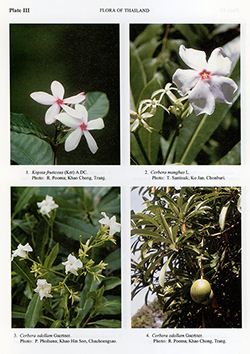e-Flora of Thailand
Volume 7 > Part 1 > Year 1999 > Page 61 > Apocynaceae > Kopsia
3. Kopsia fruticosa (Ker) A.DC.
in DC., Prod. 8: 352. 1844; Hook.f., Fl. Br. Ind. 3: 639. 1882; King & Gamble, J. As. Soc. Beng. 74(2): 430. 1907; Ridl., Fl. Malay Penins. 2: 338. 1923; Kerr, Fl. Siam. En. 2: 437. 1939; Timmerman-van der Sleesen, Fl. Mal. Misc. Rec. 1: 15. 1959; Backer & Bakh.f., Fl. Java 2: 232. 1965; Markgr., Blumea 20: 422. 1972; Tsiang & P.T.Li, F. Reip. Pop. Sin. 63: 45. 1977, Lý, Fedd. Rep. 97: 440. 1986; Li et al., Fl. China 16: 163. 1995.— Cerbera fruticosa Ker, Bot. Reg. 5: t. 391. 1819. Plate III: 1.
Accepted Name : This is currently accepted.
Description : Shrub or small tree to 10 m. Branchlets glabrous or puberulent. Leaves: petiole 3.5–12 mm long; blade coriaceous, elliptic, 7.5–22 x 3.3–9.1 cm, apex acuminate, base cuneate or acute; secondary veins 10–20 pairs; glabrous or puberulent on midrib beneath. Inflorescence corymbose; puberulent; 7–12.4 cm long; pedicels 0–2.2 mm long. Sepals ovate, 2.1–3 x 1.6–2.4 mm, apex rounded; glabrous or puberulent, ciliate. Corolla white or pink; tube 25–40 mm long; lobes 15–29 cm long, obovate, rounded; glabrous or sparsely puberulent outside, pubescent in mouth and beneath stamens inside. Stamens inserted at 22–30 mm from corolla base; filaments 0.4–0.8 mm long; anthers 2–2.3 x 0.6–0.8 mm. Disk 0.6–2 mm long. Ovary 1.1 x 2.1 mm long, glabrous or pubescent; style + pistil head 2.1–2.9 cm long. Fruit 1.5–1.6 cm long; with a large beaked appendage. Seeds 8–20.5 x 4.8–6.7 mm.
Thailand : SOUTH-WESTERN: Prachuap Khiri Khan; CENTRAL: Krung Thep Maha Nakhon (Bangkok); PENINSULAR: Phangnga, Krabi, Satun, Narathiwat.
Distribution : Burma (type), China, Malaysia, Indonesia. Cultivated elsewhere.
Ecology : In evergreen or secondary forests, often on limestone, to 500 m alt. Also frequently cultivated.
Vernacular : Tueng ta sai (ตึ่งตาใส)(Northern); phut chomphu (พุดชมพู), unakan (อุณากรรณ)(Bangkok).

